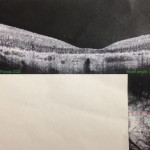So I went to the Opthamologist a couple days ago. It was my first visit in about three years, and it was just with a local Opthamologist near my house as opposed to the specialist I have always gone to downtown Chicago. I received a letter from my specialist about a year or so ago, saying that he was retiring, and since he was the main reason I went to that clinic, I opted to just get a referral from my FP. For some reason, I thought that going to a new office would lessen my anxiety, since I have never liked going to the eye doctor, but I found myself a nervous wreck the morning of my appointment.Growing up, I always dreaded the day-long visit to our Opthamologist in Chicago. His name was Dr. Fishman, a world-reknowned RP researcher and specialist, and he was the epitome of a stereotypical nerdy professor, complete with bow-tie and medical terminology that went way over my head in conversation. Since his office at UIC was a teaching hospital, I could always count on a couple “trainees” standing over me in the dark as the brightest-possible light from his nifty head-lamp shone directly in my pried-wide-open eyes. “Hold it there….steady…” I remember him saying, breath in my face (in hearing about the visits growing up, my husband affectionately nick-named him “Fishbreath”, as he could have used a good breath mint).
“See these islands and pairing here with the red pigments….” he’d begin, and for about 20 minutes in that dark room I was not Joy– a living, breathing being with hopes, dreams, fears, and feelings– I was a lab rat demonstrating the atrophy and rapid decline of millions of cells in the retina. And since I knew, even on some odd level as a child, that this doctor was doing this to hopefully find a cure one day, I’d succumb for the most part, wincing here and there when it became too uncomfortable, but mostly I’d will myself to think about “happy” things– plans for later in the day (as a child, the trips always involved stopping at Ed Debevics for lunch afterwards, so that gave me something to look forward to!)
The remaining parts of those visits usually entailed a standard eye exam, such as reading charts, dilating eyes, glaucoma test, etc. And, of course, the dreaded visual fields test, which didn’t hurt at all, but always caused anxiety since I knew that its results would tell me how much periphereal vision I had lost since the previous visit. I remember trying to fake the technician out as a pre-teen. I was only supposed to “beep” the little buzzer when I saw the light, but I’d beep it randomly, hoping that it would “up” my scores and that they’d tell me I had more vision than I did. Looking back, I wonder why I would want them to report a higher number since it obviously wouldn’t change the fact that my narrowing fields still affected my daily life. Plus, if I couldn’t fake them out as well the following visit, it would make my decline look even worse (yeah– I was not the most logical thinker as a 12-year-old). After awhile, the technician was on to my games, however, and asked me to state where the light was each time I hit the buzzer. Busted.
It was not the visual fields test that worried me a few mornings ago, however. Going to a new office, I suddenly began to think about some of the “once-in-awhile” tests that I’d have to undergo as a child– the ERGs, the photos of my eyes, and the placement of hard contacts in my eyes (can’t remember why they did that, but it hurt!) These more invasive procedures did not occur at every visit, but they were definitely tests that went on during those preliminary visits when they were first trying to diagnose my sister and I when we were kids. And since this was a first visit at a new office, I wondered whether they’d need to do similar tests.
I really didn’t need to worry. In fact, by the end of this visit, I was the one practically begging for more tests. Even though this was an appt in a major metropolitan area with a retina specialist from a major medical group, it was probably the most unthorough, basic exam I’ve ever had. While I’m not sure that’s necessarily a good thing, it definitely put me at ease. I was mostly just confused about the technology while I was there. That, and the knowledge of the technician. He seemed to know nothing about RP, and when I asked whether I was going to have a visual fields test, he looked confused and went to ask another technician. I overheard him talking to two technicians in the hallway, asking whether he should put orders in for a visual fields test. I heard one of the technicians ask, “Retinitis Pigmentosa? Isn’t that night blindness?” and another technician chime in, “Just do a family history on her. I’ve only seen the doctor order one of those fields test one time.” And this technician wasn’t joking; there wasn’t even a technician who knew how to do the field test on staff that day, so I had to schedule it for a future date. And the funniest part was that the technician decided to do his own “makeshift” fields test on me when he returned, having me just stare at his nose and tell him when I saw his finger. I had trouble concentrating on the “test” because I kept analyzing his oddly-shaped nose in my head, trying to figure out why it was so much shinier than the rest of his face.
So when another technician came to take me to get photos of my eyes, I was expecting the same rudimentary-type scenario, especialy since I remembered having my eyes held open with Q-tips as a child while photographs were taken. To my relief, there was an amazing machine that took pictures easily without any need for pried-open eyes or Q-tips. She kept apologizing while taking the pictures, saying “I’m sorry this is so uncomfortable” because she spent a lot of time readjusting my head to get just the right angle. I tried to explain to her that this was pretty much a spa treatment compared to my UIC appointments.
When looking at the Opthamologist’s name before he entered the office, I was expecting a man with a thick accent to walk in the room, and i imagined that he would throw around medical jargon like Dr. Fishman did. But within 1 minute of meeting him, I could tell that he was completely different from my lifelong specialist. He had a full set of hair, wore snazzy clothes and cologne, and was about as personable as they come. I have to admit that I was very skeptical of this younger hot shot, especially after having to explain RP to his technician, but I soon realized that he’s a retina specialist for a reason. He spoke very highly of Dr. Fishman (who, by the way, is now volunteering at the Lighthouse for the Blind and cares very much for his patients despite my lab-rat comment). He was up-to-date on all the latest research, and he was definitely the most hopeful-sounding eye doctor I’ve ever spoken to. At one point, he looked right at me and said, “With all the break-throughs in stem cell therapy, there will very likely be a cure in your lifetime that will not only stop degeneration but will most likely reverse it as well.” Wow, I think my parents, sister and I would have flipped over if we had ever heard Dr. Fishman say that 20 years ago. I remember my dad trying to press Dr. Fishman for some hope, asking very specific questions about when and if a cure would be found, and Dr. Fishman was always careful with his wording and would say “It’s possible”, but usually with nervous hesitation. I think he tried hard not to be misleading, but he definitely didn’t leave us with a feeling of hope. I usually had to get that from my parents after eye appts. I remember my dad always saying, “Science is moving ahead every day, and I truly believe that there will be a cure in you girls’ lifetime”, and I remember I loved hearing him say those words, and growing up I believed them. But there defintiely was something different about hearing a doctor say it that gives me hope as an adult.
While it gives me hope for the future, my sister and I are getting a little tired of waiting for western medicine to come up with a cure. We’ve begun to look at other routes, specifically eastern medicine, and we are equally intrigued by what we have found. In fact, my sister’s next post will talk about our upcoming treatment that we will be undergoing in just 3 weeks! Stay tuned…..



